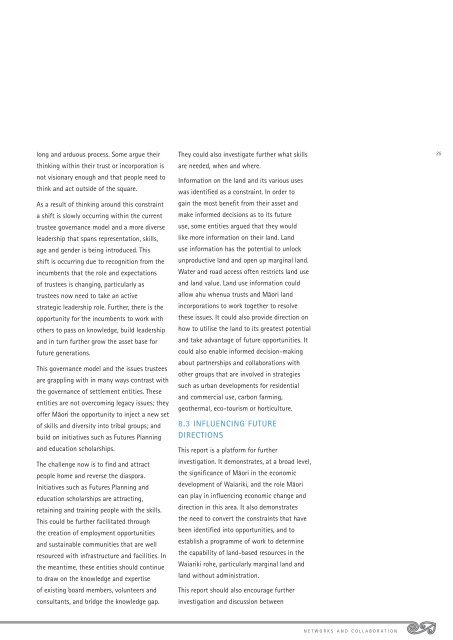Full Document: PDF 949KB - Te Puni Kokiri
Full Document: PDF 949KB - Te Puni Kokiri
Full Document: PDF 949KB - Te Puni Kokiri
Create successful ePaper yourself
Turn your PDF publications into a flip-book with our unique Google optimized e-Paper software.
long and arduous process. Some argue their<br />
thinking within their trust or incorporation is<br />
not visionary enough and that people need to<br />
think and act outside of the square.<br />
As a result of thinking around this constraint<br />
a shift is slowly occurring within the current<br />
trustee governance model and a more diverse<br />
leadership that spans representation, skills,<br />
age and gender is being introduced. This<br />
shift is occurring due to recognition from the<br />
incumbents that the role and expectations<br />
of trustees is changing, particularly as<br />
trustees now need to take an active<br />
strategic leadership role. Further, there is the<br />
opportunity for the incumbents to work with<br />
others to pass on knowledge, build leadership<br />
and in turn further grow the asset base for<br />
future generations.<br />
This governance model and the issues trustees<br />
are grappling with in many ways contrast with<br />
the governance of settlement entities. These<br />
entities are not overcoming legacy issues; they<br />
offer Mäori the opportunity to inject a new set<br />
of skills and diversity into tribal groups; and<br />
build on initiatives such as Futures Planning<br />
and education scholarships.<br />
The challenge now is to find and attract<br />
people home and reverse the diaspora.<br />
Initiatives such as Futures Planning and<br />
education scholarships are attracting,<br />
retaining and training people with the skills.<br />
This could be further facilitated through<br />
the creation of employment opportunities<br />
and sustainable communities that are well<br />
resourced with infrastructure and facilities. In<br />
the meantime, these entities should continue<br />
to draw on the knowledge and expertise<br />
of existing board members, volunteers and<br />
consultants, and bridge the knowledge gap.<br />
They could also investigate further what skills<br />
are needed, when and where.<br />
Information on the land and its various uses<br />
was identified as a constraint. In order to<br />
gain the most benefit from their asset and<br />
make informed decisions as to its future<br />
use, some entities argued that they would<br />
like more information on their land. Land<br />
use information has the potential to unlock<br />
unproductive land and open up marginal land.<br />
Water and road access often restricts land use<br />
and land value. Land use information could<br />
allow ahu whenua trusts and Mäori land<br />
incorporations to work together to resolve<br />
these issues. It could also provide direction on<br />
how to utilise the land to its greatest potential<br />
and take advantage of future opportunities. It<br />
could also enable informed decision-making<br />
about partnerships and collaborations with<br />
other groups that are involved in strategies<br />
such as urban developments for residential<br />
and commercial use, carbon farming,<br />
geothermal, eco-tourism or horticulture.<br />
8.3 INFLUENCING FUTURE<br />
DIRECTIONS<br />
This report is a platform for further<br />
investigation. It demonstrates, at a broad level,<br />
the significance of Mäori in the economic<br />
development of Waiariki, and the role Mäori<br />
can play in influencing economic change and<br />
direction in this area. It also demonstrates<br />
the need to convert the constraints that have<br />
been identified into opportunities, and to<br />
establish a programme of work to determine<br />
the capability of land-based resources in the<br />
Waiariki rohe, particularly marginal land and<br />
land without administration.<br />
This report should also encourage further<br />
investigation and discussion between<br />
35<br />
NETWORKS AND COLLABORATION

















